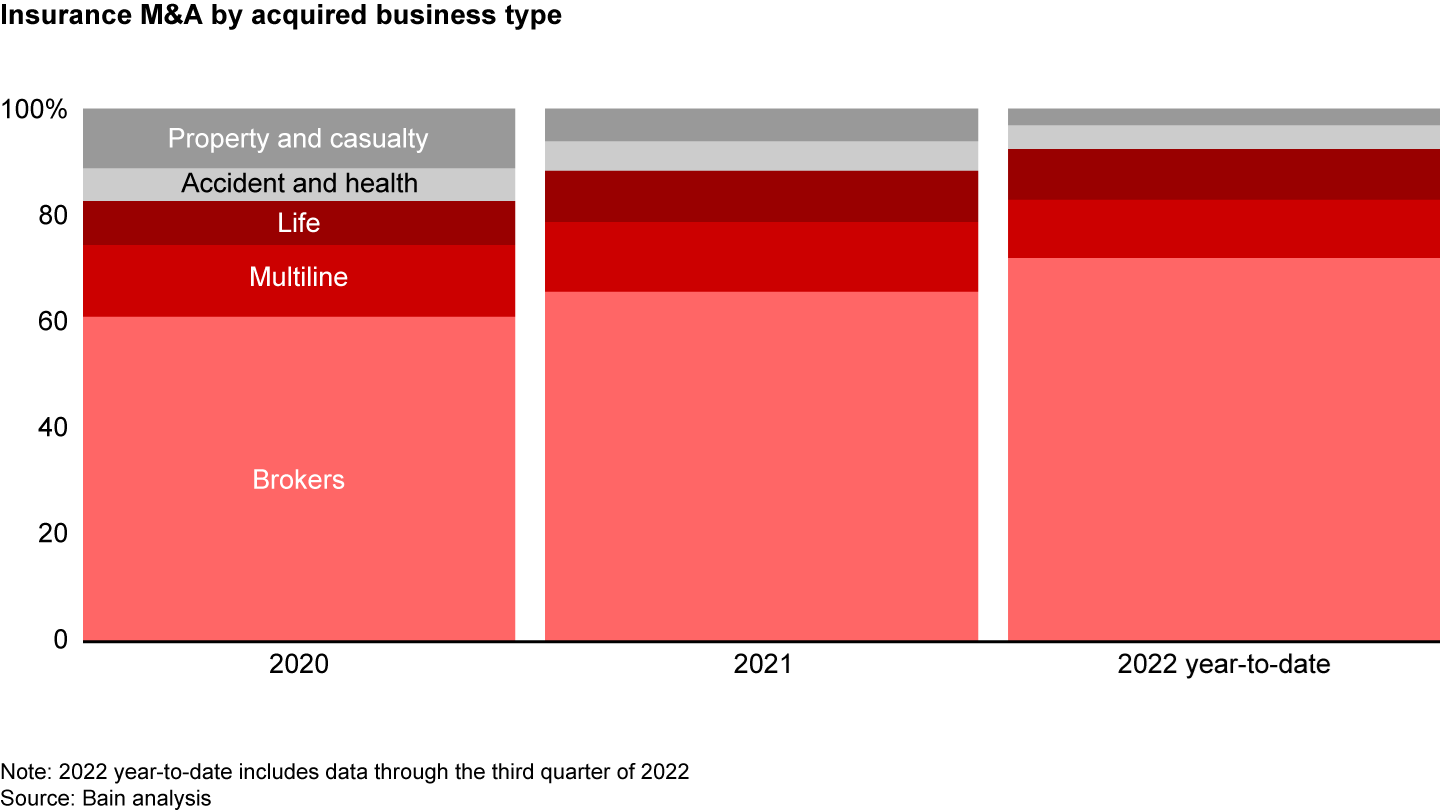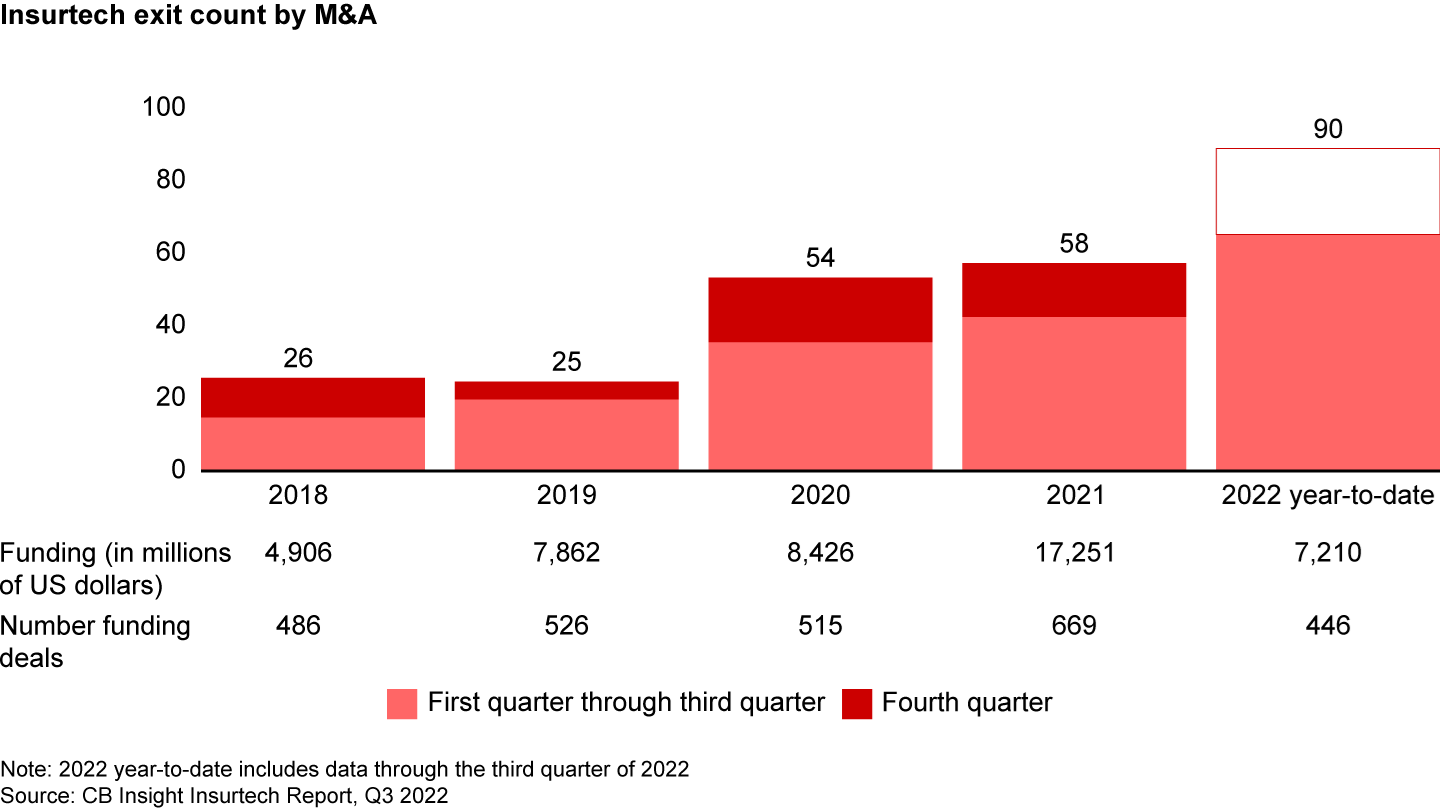M&A Report

At a Glance
- While 2022 insurance deal volume was roughly flat, the mix shifted toward more brokerage deals and fewer carrier deals.
- Insurtech acquisitions have remained strong, even as marquee public insurtechs have struggled.
- Insurers looking for innovative capabilities must do their due diligence to make sure they are getting what they think they are buying.
This article is part of Bain's 2023 M&A Report.
This time last year, we expected to see insurers continue to use M&A to expand their capabilities and distribution reach in 2022. While the total volume of insurance deals for the first three quarters of 2022 was roughly equal to the volume for the similar period in 2021, there was a meaningful shift away from carrier deals and toward brokerage deals, with the reduction in property and casualty (P&C) carrier deals being the most pronounced (see Figure 1).
As deal volume remained relatively constant, there have been fewer carrier deals and more broker deals


Integration and value realization is never easy, but on balance, brokerage acquisitions tend to deliver more of a known entity (contracts, clients, sales teams) than carrier deals, which can include a complicated mix of legacy blocks, aging technology, and systems and processes that may or may not be a good fit with the acquiring company. The shift in deal mix may reflect caution on the part of the carriers—or in the case of the P&C carriers that saw the sharpest decline, it could merely reflect the economic challenges within the core business as losses have increased over the past two years.
Interest in insurtech continues, with increased scrutiny
While the overall share of carrier deals has declined, insurtech deals are continuing to increase (see Figure 2). Insurtech has been particularly hot in recent years, with a 70% increase in investment from 2018 to 2020 (from $4.9 billion to $8.4 billion) and doubling between 2020 and 2021 (from $8.4 billion to $17.3 billion).
Insurtech acquisitions count has continued to increase as funding has receded


Even as insurtech funding decreased in 2022 from an exceptional year in 2021 ($7.2 billion through September 2022 vs. 2021’s $17.3 billion), insurtech acquisitions have continued to accelerate, with strategic buyers still on the hunt for advanced capabilities.
At the same time, it is important to take lessons from the struggles of public insurtechs. The potential of innovative businesses does not always match the reality; customer acquisition costs are high, and effective underwriting is hard. This is especially true when market conditions change. The market capitalization of 2020 and 2021 marquee IPOs have fallen dramatically. For example, Lemonade’s market cap dropped by 48% from July 2020 to October 2022, and Root’s fell by 98% from October 2020 to October 2022. By comparison, incumbents have grown market capitalization by about 50% from July 2020 to October 2022.
As we work with our clients, we see increased scrutiny of potential deals—and for good reason. In a recent commercial due diligence on an exciting and seemingly promising fintech asset, the potential acquirer discovered that behind the early client successes, there was little more than Google Forms. Our client’s enthusiasm for the asset rapidly evaporated with the realization that while the story was exciting, this business was far from a platform from which to build.
In another recent commercial due diligence on a high-profile insurtech asset, our work found that despite a compelling story for unlocking future growth via revolutionary technology, the business was actually creating the impression of a breakthrough technology stack while solving its problems through old-fashioned, human brute force. While still an interesting business, the upside potential that our client was looking for clearly did not exist—and they walked away better informed.
In diligence, a potential acquirer discovered that behind the early client successes, there was little more than nice spreadsheets.
We are also seeing clients think harder about pursuing innovative assets for innovation’s sake. One client recently suspended pursuit of a recognizable insurtech, stepping back to ask essential questions about whether it would really advance the company’s strategy. Yes, the capabilities were intriguing. But were they really going to help the insurer achieve its ambition?
Caveat emptor
Given the challenging times and reduced funding for both well-known and emerging insurtechs, there are certainly deals to be done, but it is essential to go in with your eyes open. Below are three essential steps.
Step No. 1: Make sure you have a clear strategy and understanding of capabilities before pursuing deals. M&A is a tool to advance your strategy, not a strategy in and of itself. It is certainly not a silver bullet solution. If you have conviction about where you are headed and the capabilities you need, M&A can be considered (alongside internally building and partnerships) as a viable path toward acquiring the required capabilities. Without this clarity, however, you are inviting buyer’s remorse if you just blindly go shopping.
It is certainly true that many incumbents struggle to develop innovative capabilities; finding the right asset at the right price and then successfully integrating it, however, brings an additional range of challenges that most organizations struggle to pull off successfully.
There are certainly deals to be done, but go in with your eyes open.
Step No. 2: Do a real diligence before you agree to a deal. In Bain’s M&A Practitioners’ 2023 Outlook Survey, financial services deal teams led all industries for pre-close estimates that were materially inaccurate for revenue and go-to-market synergies (60% of the time) and technology (48% of the time).
Drawing a link to the above point on strategy, diligence must focus on the issues that will have the biggest impact on a deal’s success.
If you are seeking a capability or technology, is the target’s technology robust and scalable? Once you look behind the curtain, is the great and powerful Oz truly as impressive as it initially seemed? Or is it just a glorified spreadsheet similar to what our client discovered in the example above?
If you are seeking access to distribution and customers, what is the cost to acquire customers? What is the customer lifetime value? What is the retention to date, and what’s expected with a change of control? Going forward, will the sales motions that built the target’s early success work with or alongside the motions of the rest of your organization?
If you are seeking talent, are the people who were attracted to this "exciting fintech disrupter" going to thrive within your "boring insurance company?" While this certainly is a perception challenge, the bigger issue is the high likelihood of dramatically different ways of working. The prudence that protects 100-year (or more) legacies generally involves decision-making processes that are the opposite of moving fast and breaking things.
The goal of diligence is not to kill the deal—although this is sometimes the most valuable outcome—but rather to make sure that you have a clear understanding of what you are getting into and can begin to plan to address the inevitable risks and challenges.
Step No. 3: Be honest about what it will take to integrate assets and realize full value, and tailor your expectations and approach. Adding to the dubious distinctions in our M&A practitioners’ survey, financial services deal teams also led the pack in materially overestimating synergies and their ability to manage the integration roadmap (50% of the time).
Scope and capability deals generally have lower cost synergies than scale deals. You should absolutely pursue these synergies. But be sure to set the right aspirations, and don’t just rely on benchmarks from previous scale deals.
We believe it is essential to tailor the integration approach to the specifics of the deal at hand with a clear integration thesis.
Your integration thesis should clarify the following:
- ambition (degree of transformation and specific financial and nonfinancial targets);
- where to focus (critical value drivers, pivotal decisions, and risk);
- what to integrate (by business unit, function, and geography, with a specific view toward the operating model and an appreciation of technology and process requirements); and
- when and how to deliver (clear view of phasing and milestones, operating principles, structure, and governance for the integration).
A strong integration thesis helps ensure that you pursue the integration with the same focus and rigor with which you pursued the deal and that you are grounded in maximizing and realizing value. An integration approach disconnected from this pursuit of value can create early friction at a critical time when organizations are still learning about each other and how to best work together going forward. Once again, blindly applying generalized best practices can get you into trouble.
With valuations and funding down, it may be a great time to buy insurtech assets, but you must do so with open eyes. Know what you are looking for and why, make sure you are getting what you think you are buying, and have a clear plan to ensure that you realize the value.